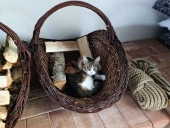posted 11 years ago
Potters mix clay with sand in a pug mill to get a clay that will set and hold together well when fired in a Kiln. Adding sand alone will not improve drainage of clays.
Organic matter is what helps loosen clay soils, the minute clay particles will coat the organic matter making microscopic pills which do not bind together as readily as pure clay particles. As you amend clay soil with more and more organic matter the clay particles become less frequent and so less able to bind together, at that point the addition of sand will indeed increase the drainage ability of the organic improved soil. This can be done in a single season with virgin clay soil (no organic material present at the start) but to successfully do so will require a minimum 5 to one ratio of addendums to the starting soil. Any organic material will work for this, composted leaves, composted manures, already broken down mulches, peat moss, rotted soybean meal, etc. but cotton seed meal is one of the best because of the chemical composition of the material, the amount of surface area it provides for clay particle binding is higher than almost any other organic material you can get.
I have created many rose beds (very demanding of being put in very good, loose soil, for best growth and production of blooms) out of red clay soils in one season by adding vast quantities of cotton seed meal, finished compost and leaf molds, these beds perform best if left to meld for a winter. In the spring come back with a second application of amendments and then add 1 part sharp sand, at that point introduction of rose bushes will succeed very well. I have also built vegetable garden beds in a single season that produced their first spring planting using the same methods as for roses. It is always good to do a soil test after letting a freshly created bed have its over winter rest, that way you can make any adjustments to PH and nutrient needs. Continuing an amendment schedule for any soil can really do nothing worse than making the soil better as long as you remember to do a soil test to see where you are and adjust accordingly.




